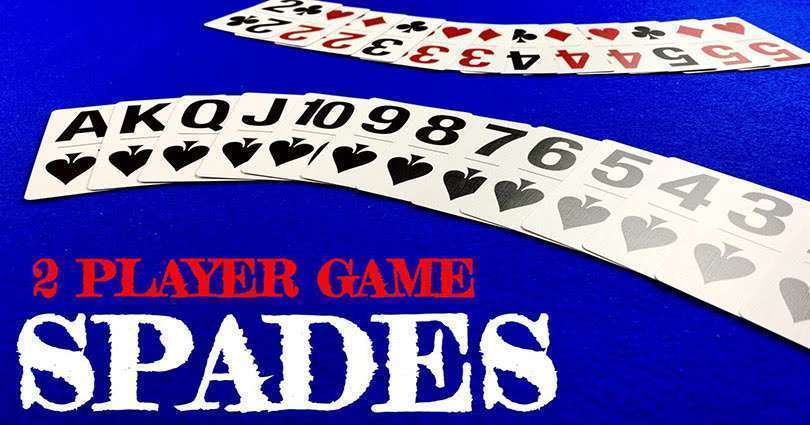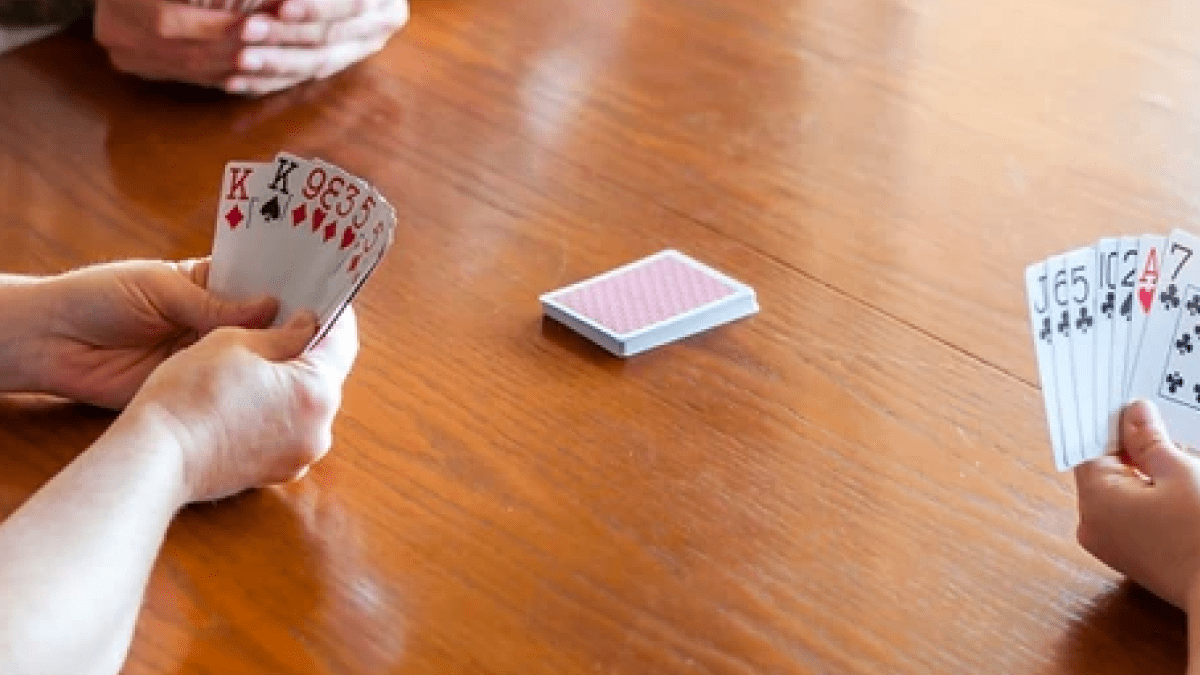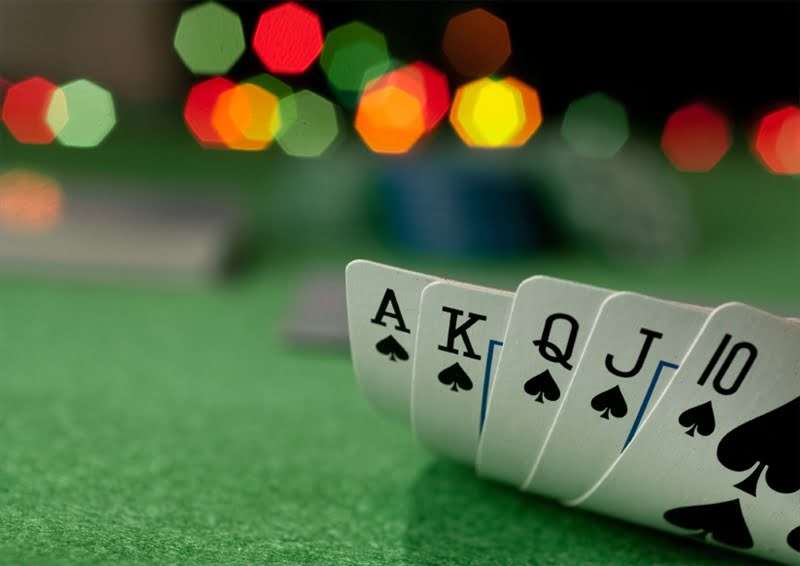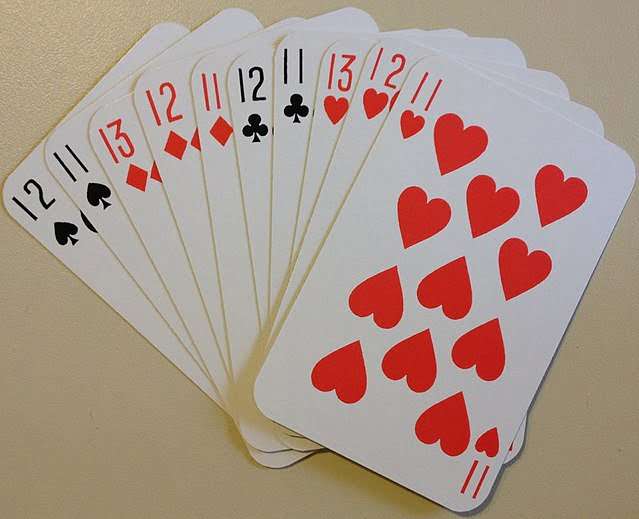Sports
2 Player Spades 2022 – Everything you need to Know

Table of Contents
2 Player Spades is a fantastic trick-taking game for two players. The game revolves around the participants’ estimates of how many tricks they believe they can pull off.
Players who take a small number of tricks, as well as those who take an excessive amount of tricks, are both punished.
Spades is often played in four-player teams, however, this variant allows just two players. So, if you have a playing partner, go ahead and learn how to play a 2 Player Spades.
To be the first player to reach 500 points is the objective.
The total number of players is two.
Number of Cards — A 52-card deck with no jokers is used.
Spades always trump. Rank of Cards: 2 (low) – Ace (high). Each suit’s cards are graded from highest to lowest: A K Q J 10 9 8 7 6 5 4 3 2.
Adults are the target audience for this trick-taking game.
Setup
Let’s begin with the most fundamental phase of every card game: setup. The game begins with the deck being shuffled and a player drawing the top card from the pile. The player then selects whether or not to keep the card. If they keep it, the second card must be placed face down in a discard pile. If the player does not want to keep the first card, he must discard it face down in a discard pile.

The second player then repeats the process with the deck’s following two cards. This procedure is repeated until the complete deck of cards has been gathered.
As a result, each player will have 13 cards towards the end of the game. So, what about the other 26 cards? These cards are kept apart from the rest of the deck and are not utilized in the game.
How to Handle It
The most enjoyable aspect of 2 Players Spade is that there is no deal in the game. After the cards have been shuffled, the two players will take turns forming their 13-card hand, one card at a time.
The first player selects a card from the top of the file and may take it or place it face up in the discard pile.
If the player chooses to keep that card, the following card is dealt face up and becomes the discard pile. If the second player joins in, the result is the same.
Player 2 is dealt a card, which he or she might retain or discard. In the event that they keep it, the following card must be discarded. The same procedure is followed until each player has 13 cards.

Bidding
In this card game, there is just one round of bidding. All of the players look at their hands before deciding on their trick bid. Note that spades are always trump in this game, and the non-dealer bids first. The bid might be anything from 0 and 13 tricks.
Going nil is when a player bids zero, indicating that they feel they will not be able to take any tricks. Special points are awarded if this type of bid is successful. Each opponent must bid, indicating how many tricks he anticipates from the total of 13 potential tricks.
Shooting the Moon is a bet made by a player who believes they can take all 13 tricks. Special points are granted for each trick if it is successful. One trick’s winner advances to the next.
The participants in 2 Players Spade, on the other hand, do not have to outbid each other. The participants can pick how many tricks they believe they are capable of taking. It is necessary to record the bids.
Double Nil
A player might bet double zero, commonly known as blind nil, before drawing their first card. After putting two zero bets, the player can examine at his cards and discard up to three of them, replacing them with cards drawn at random from previously discarded piles. If the player is successful in doing so, they will receive a bonus of 200 points. What if they don’t succeed? So, they’ll have to accept a 200-point penalty.
How to Play the Spades Game
The player who is not a dealer is the first to play. The game begins with the player selecting a card and placing it in the center of the table. It’s worth noting that you can’t play Spades until the suit is broken.

When a player can’t follow suit or only has spades remaining in their hand, the Spades are broken. If they are unable to follow suit, they may play any card they like. As a result, you must follow suit.
If they can, the opposing player must play in the same suit as them. However, if they are unable to follow the suit, they are free to play whatever card they wish. The trick is won by the player who plays the highest card in the suit or the highest spade.
The player who was the recipient of the trick is the next to play. The game continues in this manner until each player’s 13 cards have been played. Dealing is done alternately between the two players.
What is the meaning of Spades Breaking?
This word is used in the game when a player plays spade instead of the suit. Spade breaking is the term for this. When the player has no other choice than to lead the spade, the spade is broken.

Scoring
A player receives ten points for each trick that assisted them in meeting their bid. So, if a player bids 9 and takes 9 tricks, each trick is worth 90 points. Additional tricks are awarded an extra point apiece.
If a player wins a trick in excess of their bet, they are referred to as Bags and are worth one point apiece. If a player bids 9 but takes 11 tricks instead, they are awarded 92 points. The score would be 70 if the player’s stake was seven and he performed seven tricks.
However, there is one thing you should keep in mind. A player loses 100 points for every ten bags stolen. According to the “sandbag” regulations, a player pays a 100-point penalty every time he or she wins 10 bags (accumulated during a game).
When a player fails to fulfill their bet, 10 points are removed for each trick bid. So, if a player made nine offers but could only accept five, they would lose 40 points.
If a player successfully bids 0 or goes nil, they are awarded 100 points. The extra bids are classified as bags if they fail to take zero tricks.
When a player bids 13, i.e., shoots the moon and succeeds, they are awarded 250 points.
If a player who shoots the moon does not complete all 13 tricks, the tricks they do complete are considered bags. If a player bids 13 and only takes 9 tricks, they will receive 9 points.
However, if these bags total 10, their score is reduced by 100 points.
Who will win the two-player spades game?
The player with the most tricks gets 2 Player Spades if he or she is the first to 500 points.
That was all there was to it when it came to 2 Players’ Spades. I hope you found the post helpful and that you were able to grasp how to play the game as well as the game regulations.
Please feel free to ask any questions you may have regarding this classic game in the comments area below. We will react as soon as we can.
Variations on the Game
Spades, like any widely played game with such a versatile character, has a plethora of variations, ranging from major gameplay alterations to minor tweaks to fit individual or family tastes.
Deal Variations
Deficient Hand: A deficient hand is one in which a player is given a hand with one or no spades or face cards. This is referred to as deception. Before he or his team bids, a player who wishes to notify a misdeal decision owing to a deficient hand must dump his hand face to face so that other players can evaluate it and declare “misdeal.” It is not necessary to declare a foul hand offense; instead, a player may attempt to gamble “zero” when the hand is dealt.
Face-up deal: The dealer can disclose up to four face-up cards per player in this version, as long as the same number is exposed for each player. The psychological warfare of bidding and the accompanying game known as power checks can be triggered by this exposure of the cards, but occasionally dealers conduct open transactions that set up the deck to test whether the cut has disrupted their plans.
Deuce Starts: Regardless of who dealt first, the player with two spades is always the first to lead the game with a card of the same suit. In the game of hearts, a similar rule applies.
Kitty: Kitty is a collection of leftover cards that are placed in the center of the board. When playing a game with several players when the cards cannot be dealt evenly, this is done. As a result, no cards from a conventional 52-card deck are eliminated. Before the bidding begins, whoever receives the 2 or the person with the highest offer (the tiebreaker is the first to bid) picks up the kitten, They then place the equal amount of Cards in their hand. It counts as a trick if extra cards are added to the cat and the player who picks up the kitty discards a card.
Bidding Variations
Sum of bids: This version is based on the game Oh hell, which is similar. It states that the total of all bids placed throughout the game should not equal the number of tricks. Why is this rule in place? It guarantees that at least one person or team has been set or bagged. After all players have bid, but before the game begins, another form of the game allows each player to increase their bet by one point. Bid reductions are never permitted once bids have been filed.
Nil: A player can bid nil if he has already glanced at his cards. The bidder’s purpose during the hand is to avoid any trickery. The player’s partner can make a regular bid and then assist him by attempting to do tricks that the zero bidder would normally perform. Successful zero bids are uncommon in solo / ruthless spades because there is no partner available to take the highest cards from the bidder. If the zero bidder does not pull any tricks, he earns the zero bonus; if the player or team fails, the bonus is deducted.
Double Nil: The team’s nil incentives are doubled if two players in a partnership bid nil successfully. However, there are no consequences if one or both players fail to make their bid.
Blind bidding: Almost every game has a variation where one or more players who haven’t looked at their cards yet can determine how many tricks to perform. Bonus points will be awarded to players that are blind bidding and have bids that are exactly identical. If this is not the case, the extra point is subtracted from the player’s team score. The number of people who can bid blindly is restricted to seven. As a result, betting a blind of 8 or more is against the rules and is not permitted. When the bidding team is down by at least 100 points, this phenomena known as blind bidding is frequently allowed.
Blind Nil: The most popular blind bet by players is to play the hand without doing any tricks. In addition to blind bidding, bidding from scratch provides an additional benefit. When a zero offer fails, the bonus is subtracted from the score, same to when a blind fails.
Double Blind Nil: Both players in a partnership have the option of bidding Blind Nil. The team either wins the game outright or earns double the aggregate bonus if they are successful. There is no penalty if one or both players do the stunts.
When someone plays spades, you might not observe players passing or swapping cards with each other. This is due to the fact that it is a choice. Though passing is utilized in some tough situations, such as when a blind offer is made. An association in which a player has bid Nil or Blind Nil may opt to pass two cards amongst the participants to compensate for this issue; Typically, one card is used for conventional nil and two cards are used for blind nil.
CLICK HERE: FOR MORE READING ABOUT UPDATED TIME AND PLEASE FOLLOW ME ON FACEBOOK, TWITTER
Bidding as a team: In this version, partners can “talk” during the bidding round and bid as a team rather than as individuals. The partnership that hasn’t reached an agreement gets the first crack at bidding. The opposing team might utilize this to their advantage when putting together their own offer. By the way, the total number of trickery bids does not have to be 13 to be valid. Players can talk about how many tricks they think they can pull off with each other, but any talk about a specific card or the power of a certain suit is considered “cross boarding” and will result in a poor deal, therefore the punishment will be to pass. The Agreements can be moved to the left to earn a penalty of up to 100 points by adding a specified number of “bags” to the offending society.
Sports
Keonhacai live Keonhacai.video Is Best for live sports streaming

Table of Contents
Keonhacai live Keonhacai.video, stands as a dynamic hub for live sports streaming, offering enthusiasts unparalleled access to a diverse array of sporting events. This introduction provides an overview of the platform’s immersive experience, exploring its wide range of sports coverage, user-friendly interface, and the convenience of real-time access to live sports action. Join us as we delve into the world of Keonhacai.live, where sports fans can unite to witness their favorite teams and athletes in thrilling live competitions, all from the comfort of their own screens.
The Diversity of Sports Offered on Keonhacai live Keonhacai.video
Keonhacai live Keonhacai.video boasts an extensive selection of sports, catering to a wide range of interests and preferences. From popular mainstream sports like basketball, football, and tennis to niche sports such as cricket, rugby, and MMA, the platform offers something for every sports enthusiast. Whether you’re a fan of international competitions, league matches, or local tournaments, Keonhacai.live ensures comprehensive coverage of various sporting events from around the globe. With its diverse lineup, Keonhacai.live stands as a go-to destination for sports fans seeking to immerse themselves in the excitement of live sports action.
Accessing Live Sports Events in Real-Time
Keonhacai.live provides users with the unique opportunity to access live sports events in real-time, delivering the thrill and excitement of the game directly to their screens. Through its intuitive interface and seamless streaming capabilities, the platform enables sports enthusiasts to stay connected to their favorite teams and athletes as events unfold. Whether it’s a crucial match in a major league or a thrilling tournament showdown, users can enjoy the action as it happens, ensuring an immersive and dynamic viewing experience. With Keonhacai.live, accessing live sports events in real-time has never been easier or more convenient.
Keonhacai live Keonhacai.video Quality of Streaming
The quality of streaming on Keonhacai live Keonhacai.video is paramount, ensuring users enjoy a seamless and immersive viewing experience. The platform employs advanced streaming technology to deliver high-definition video and audio, allowing users to witness live sports events with clarity and precision. With adaptive bitrate streaming, Keonhacai.live dynamically adjusts the video quality based on users’ internet connection speed, ensuring smooth playback and minimizing buffering.
User Experience and Interface on Keonhacai.video
Keonhacai.video prioritizes user experience by offering an intuitive and user-friendly interface designed to enhance the overall viewing experience. The platform’s interface is thoughtfully organized, allowing users to navigate seamlessly between different sports, events, and streaming options. With clear menus, easy-to-use search functions, and personalized preferences, Keonhacai.video ensures that users can quickly find and access their desired live sports content with ease.
Tips and Tricks for Maximizing Your Experience on Keonhacai live Keonhacai.video
To enhance your experience on Keonhacai live Keonhacai.video, consider implementing the following tips and tricks:
Optimize Your Internet Connection: Ensure a stable and high-speed internet connection to prevent buffering and interruptions during live sports streaming.
Explore the Platform: Take time to familiarize yourself with Keonhacai.live’s interface and features, such as search functions, personalized preferences, and interactive options.
Check Compatibility: Verify that your device and browser are compatible with Keonhacai.live to ensure smooth streaming performance.
Customize Your Settings: Adjust video quality settings according to your internet speed and preferences for an optimal viewing experience.
Utilize Interactive Features: Engage with live chat, social media integration, and other interactive features to connect with fellow sports enthusiasts and enhance your viewing experience.
Plan Ahead: Check the schedule of upcoming live sports events on Keonhacai.live and plan your viewing accordingly to ensure you don’t miss any exciting matchups.
Stay Informed: Stay updated on sports news, scores, and updates to enhance your understanding and enjoyment of live sports events.
Exploring Additional Features and Offerings on Keonhacai live Keonhacai.video
Beyond live sports streaming, Keonhacai live Keonhacai.video offers a range of additional features and offerings to enrich the user experience. These may include:
On-Demand Content: Access to a library of archived sports events, highlights, interviews, and analysis, allowing users to catch up on missed matches or relive memorable moments.
Multi-Device Compatibility: Seamless integration with various devices, including desktop computers, laptops, smartphones, tablets, and smart TVs, ensuring flexibility and convenience in accessing live sports content.
Personalized Recommendations: Curated recommendations based on user preferences, viewing history, and favorite teams or athletes, helping users discover new sports events and content tailored to their interests.
Interactive Viewing Experience: Engage with interactive features such as live chat, polls, and trivia games, fostering community engagement and enhancing the overall enjoyment of live sports streaming.
Statistical Insights: Access to real-time statistics, scores, and analytics during live sports events, providing in-depth insights into player performance, team strategies, and game dynamics.
Subscription Options: Flexible subscription plans offer ad-free viewing, exclusive content, and premium features for dedicated sports enthusiasts seeking an enhanced viewing experience.
Social Media Integration: Seamless integration with social media platforms, allows users to share their favorite moments, interact with fellow fans, and stay connected with the latest sports news and updates.
Conclusion
In conclusion, Keonhacai live Keonhacai.video stands as a premier destination for live sports streaming, offering users a comprehensive and immersive viewing experience. With its diverse selection of sports, user-friendly interface, and high-quality streaming capabilities, the platform caters to the needs and preferences of sports enthusiasts worldwide. By prioritizing the quality of streaming, embracing interactive features, and providing additional offerings such as on-demand content and personalized recommendations, Keonhacai.live elevates the live sports streaming experience to new heights. Whether it’s catching up on the latest matches, engaging with fellow fans, or accessing exclusive content, Keonhacai.live remains a go-to destination for sports fans seeking to stay connected to their favorite teams and athletes in real-time.
FAQs (Frequently Asked Questions) about Keonhacai live Keonhacai.video:
What sports are available for streaming on Keonhacai live Keonhacai.video?
Keonhacai live Keonhacai.video offers a diverse range of sports, including football, basketball, tennis, rugby, cricket, MMA, and more. Users can access live coverage of various international competitions, league matches, and tournaments.
Is Keonhacai live Keonhacai.video free to use, or do I need to subscribe?
Keonhacai live Keonhacai.video may offer both free and subscription-based options for accessing live sports content. While some events may be available for free streaming, premium features and exclusive content may require a subscription fee.
How can I access Keonhacai live Keonhacai.video on different devices?
Keonhacai live Keonhacai.video is compatible with a wide range of devices, including desktop computers, laptops, smartphones, tablets, and smart TVs. Users can access the platform through web browsers or dedicated mobile apps available for iOS and Android devices.
Can I watch archived sports events on Keonhacai live Keonhacai.video?
Yes, Keonhacai live Keonhacai.video may offer on-demand content, including archived sports events, highlights, interviews, and analysis. Users can catch up on missed matches or relive memorable moments at their convenience.
Is streaming on Keonhacai live Keonhacai.video legal and ethical?
Keonhacai live Keonhacai.video strives to operate within legal and ethical guidelines, obtaining proper licensing agreements and permissions for streaming live sports content. Users should also adhere to legal requirements and respect intellectual property rights when accessing content on the platform.
Sports
From Players to Fans: The Best Hockey Gifts for Everyone

Table of Contents
Hockey isn’t just a sport; it’s a passion that brings together players, fans, and communities. Whether for a die-hard fan or an aspiring player, finding the perfect hockey gifts can be as exciting as the game itself.
With the right gear, memorabilia, and fan accessories, you can bring the thrill of the ice into your home or enrich an athlete’s training routine. In this guide, we’ve handpicked must-have hockey items that will score points with anyone who lives and breathes the game.
Read on!
Customized Jersey
Nothing screams support like a customized jersey with your loved one’s name or favorite player’s number. A personalized jersey is a centerpiece among hockey gifts, allowing fans and players to feel a deeper connection to the game. It’s not merely apparel; it’s a badge of honor.
Jerseys come in various sizes, styles, and colors for men, women, and children. Whether it’s an NHL team jersey or a local club’s design, you can’t go wrong with this classic gift.
Moreover, you can also customize the jersey with additional features such as patches, stitching, and logos to make it truly one-of-a-kind. And with advancements in technology, you can even design a jersey online and have it delivered right to your doorstep.
Hockey Stick Bag
For the players, transporting their equipment is part of the ritual. A durable hockey stick bag makes the process easier and also protects the gear that helps them perform their best. With various styles and team logos available, stick bags mesh functionality with fandom.
This bag is a thoughtful present for athletes of all levels, from beginners to seasoned players. It’s an essential item that ensures their gear stays organized and accessible on the go.
Team Logo Apparel
From sweatshirts to hats, team logo apparel lets fans wear their pride for their favorite NHL team. It’s the kind of hockey merchandise that supports the spirit of the game whether you’re at the rink or simply running errands.
Logo apparel is a surefire way to make a fashion statement and show your loyalty to the team. Plus, with so many options available, you can find the perfect style for any fan. This gift is a win-win for both the recipient and their team.
Training Aids
If you want to help a player improve their skills, look no further than the latest training aids. These tools are designed to simulate on-ice scenarios, improving skills like shooting accuracy, stickhandling, and passing. They ensure that training can happen anywhere – no ice is required.
These aids are also great for players of all levels, from beginners to professionals. With the right training tools, they can take their game to the next level.
NHL Video Game
Bring the lightning-fast action of hockey into your living room with an NHL video game. It’s the perfect gift for those who want to experience the excitement of the NHL season all year round. Play with friends, and family, or dive into a solo career that takes you from rookie to pro.
Video games are a great way to bond with fellow fans or pass the time during the off-season. Plus, the graphics and gameplay make it feel like you’re right on the ice.
Hockey Puck Display Case
For the collector in your life, a hockey puck display case allows them to showcase their signed pucks or game-used memorabilia. It’s not just sports memorabilia; each puck tells a story of games watched, players admired, and memories made.
You can even find a hockey puck as a signed hockey memorabilia online. A puck signed by a favorite player or team not only adds value to the collection but also serves as a cherished keepsake.
Skate Blade Covers
Protect the blades that glide across the ice with high-quality skate blade covers. They are essential for any player, ensuring that their skates remain sharp and ready for action. Plus, they come in various designs, adding a personal touch to a player’s kit.
These covers are also a great gift for figure skaters or anyone who loves to skate. They keep blades safe during transport and protect them from scratches.
Tickets to a Game
Experience the electricity of a live game by gifting tickets to see an NHL match. The energy, the crowd, the competition – it’s an unforgettable gift for any hockey enthusiast. Watching professionals in action is not only thrilling but inspiring for players of all levels.
This is best given as a group gift, allowing friends or family to bond over their shared love for the game. It’s an experience that won’t soon be forgotten.
Training Equipment
Help your favorite hockey player train like the pros with professional-level training equipment. From plyometric platforms to resistance harnesses, the right equipment can elevate any athlete’s game and physical fitness to new heights.
This is such a good idea, especially for players looking to improve their strength and agility. With the right training equipment, they will be able to push themselves and see results on the ice.
Hockey-themed Home Decor
Transform a space into a hockey haven with team-inspired home decor. Think of team flags, bean bags, bedspreads, and even wall decals. This type of fan accessory brings the spirit of the game into your everyday life.
Moreover, it’s a great way to show off your team pride, especially when hosting game nights or gatherings. It also makes for a unique and thoughtful gift that will be appreciated by any hockey fan.
Shop For the Best Hockey Gifts for Everyone
The love for hockey transcends the rink, and so does the joy of receiving thoughtfully chosen hockey gifts. Whether you’re shopping for a player eager to improve their game or a fan who cherishes every goal, assist, and power play, these gifts are sure to delight and inspire.
Dive into the world of hockey merchandise, where every item is more than just a gift – it’s a piece of the passion that defines the sport.
Remember, gifting is not just the act of giving; it’s a way of connecting with the special hockey enthusiasts in your life.
Sports
Choosing the Perfect Online Casino

Table of Contents
In the digital era, there is a myriad of online casinos, and therefore, selecting the best platform towards an exciting gambling experience can be overwhelming. Uniqueness in features and games, including bonus offers, is what characterizes every online casino. In this write-up, three important factors that should influence your pick for the right online casino to match up with your tastes and offer a secure playing environment are what we will discuss here.
1. Licensing and Security:
The foundation of a trustworthy online casino lies in its licensing and security measures. Before diving into the world of digital gaming, it is essential to verify that the online casino holds a valid gaming license issued by a reputable regulatory authority. These licenses signify that the casino operates under stringent regulations, promoting fair play and player protection. Another important issue that should not be disregarded is security. An online casino ought to use powerful encryptors for example SSL (Secure Socket Layer) to shield your private records and money. Select platforms that take players’ security seriously, always checking customer feedback about casinos before making your choice.
2. Game Selection and Software Providers:
The perfect online casino for you should offer a diverse range of games that cater to your preferences. Whether you’re a fan of classic table games, immersive slots, or live dealer experiences, a well-rounded game library ensures that you’ll never run out of options.
Equally important is the reputation of the software providers that power the casino’s games. Renowned developers such as Microgaming, NetEnt, and Playtech are synonymous with quality, fairness, and innovative gameplay. Visit Official Website for the casino’s list of software providers and research their reputations to ensure that you’re engaging with games that are not only entertaining but also adhere to industry standards for randomness and fairness.
3. Promotions and Customer Support:
Promotional offerings can significantly enhance your online casino experience, providing additional value and excitement. Look for online casinos that provide enticing welcome bonuses for new players, as well as ongoing promotions, loyalty programs, and VIP schemes for regular patrons. However, it’s crucial to read the terms and conditions associated with these promotions to understand any wagering requirements or restrictions.
Customer support is another pivotal factor in evaluating the suitability of an online casino. Opt for platforms that offer responsive and comprehensive customer support services. This includes various communication channels such as live chat, email, and phone support, ensuring that assistance is readily available should you encounter any issues or have inquiries. The efficiency and friendliness of customer support can significantly impact your overall satisfaction with the online casino.
Choosing the perfect online casino for Muay Thai Online requires careful consideration of licensing and security, game selection, and the quality of promotions and customer support
if you focus on these most important considerations during a casino’s exploration, you can choose an appropriate platform for yourself among such a variety. Do not forget that only such online casinos as one providing a smooth combination of entertainment, security, and customer satisfaction can be called perfect.
-

 Travel4 years ago
Travel4 years agoThe Family of Kirk Passmore Issues a Statement Regarding the Missing Surfer
-

 Technology4 months ago
Technology4 months agoManyroon: The Key to Unlocking Future-Proof Business Solutions
-

 Cryptocurrency1 year ago
Cryptocurrency1 year agoBest Tips For Cryptopronetwork com Contact 2024
-

 Technology3 years ago
Technology3 years agoPaturnpiketollbyplate Login & Account Complete Guide Paturnpike.com
-

 Law3 years ago
Law3 years agoShould I Hire a Lawyer For My Elmiron Case?
-

 Business4 months ago
Business4 months agoCoyyn.com Gig Economy: Smart Contracts and Fair Payments for Freelancers
-

 Apps & Software2 years ago
Apps & Software2 years agoFapello 2023: Social Media Platform for NSFW Content
-

 Business4 months ago
Business4 months agoAcumen: The Key to Smart Decision-Making and Success






